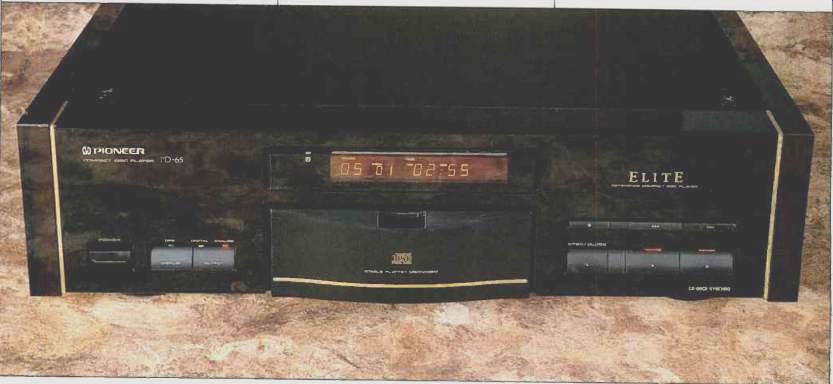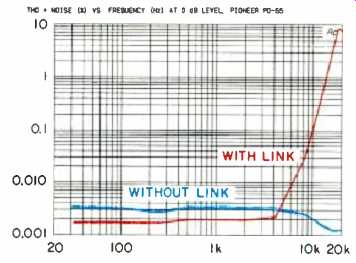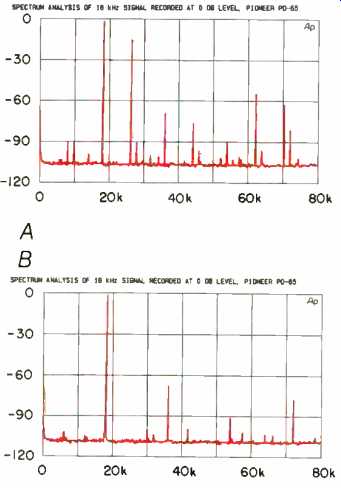
Company Address: P.O. Box 1540, Long Beach, Cal. 90801.
Rather than sounding too bright (as I might have thought), the unit with Legato Link sounded more pleasant and less raspy than the unit lacking this feature, especially on the flute solo and the percussion examples. Once I had established that there was an audible difference--however subtle--I was anxious to see if I could correlate this difference with measurements on the test bench.

Sometimes it's hard to tell when the improvements touted by makers of CD players are real and when they are mere advertising ploys. Listening and bench tests assess the overall merits of a product--but without settling whether those merits are really due to the touted improvement. So I did something different by evaluating the Pioneer Elite PD-65 both with and with out its claimed improvement.
One of the major advances Pioneer claims for this player is its Legato Link digital filter system, used in both the $800 Model PD-65 and the $450 Model PD-52. What, exactly, is Legato Link? Let me quote from the manufacturer's press release:
Pioneer's Legato Link conversion system improves CD sound quality by re storing high-frequency signals. Legato Link technology incorporates a proprietary integrated circuit to infer frequencies above 20 kHz, which have been eliminated in all CD recordings.
During the standard CD recording process, the ultra-high frequencies are omitted from the digital-to-analog (D/A) conversion process, thus slightly altering reproduction of the original instrumentation. This conversion process re creates the lost sounds in existing CDs during digital signal processing.
In order to evaluate the merits of Legato Link, Pioneer sent us two samples of the PD-65, one of which had been modified by the substitution of a more conventional digital-filter IC. Normally, I'd have put both units on the test bench and done my listening later.
This time, however, I thought it better to listen first, so that my judgments would not be influenced by any measured differences between the two units. I used selected musical tracks from my Pierre Verany test discs, including vocal selections, chamber music with flute solo, and contemporary music emphasizing percussion instruments. The differences between the two players were certainly subtle, but they were there! (Mind you, at my age I am lucky to hear pure tones of around 16 kHz, let alone tones above 20 kHz, as implied by the description of Legato Link. Nevertheless, I and others have long since proven that what one car hear as a pure sine-wave tone bears no relationship to what one hears when listening to complex musical material, rich in harmonics and overtones.)--they were definitely there.
Before discussing the test results, I should mention that the PD-65 boasts another unusual feature: A stable-platter design employing a heavy aluminum platter and a non-resonant mat to support the entire CD surface during rotation. As a result, it is necessary to load CDs with the label side down. The optical pickup assembly rides above the disc rather than below, where it is in most other CD players. Both samples had this mechanism, of course, so I cannot attribute any sonic differences between them to it.
My first surprise came when I measured the frequency response of both players. The unit with Legato Link exhibits a gentle roll-off beginning at around 10 kHz (Fig. 1A). The expanded vertical scale in the figure makes this roll-off look steep, but note that it only amounts to about 2 dB at 16 kHz.
The unit lacking the Legato Link filter has essentially flat response; at 20 kHz it's-0.2 dB (Fig. 1B). Could the slight roll-off in the Legato Link unit account for its somewhat smoother, mellower sound? Wait, the plot thickens! Next I measured THD + N as a function of frequency (Fig. 2). The Legato Link unit exhibits remarkably low THD + N at mid-frequencies (around 0.002%), but above 4 kHz, it rises steeply, reaching 0.1% at 10 kHz and approaching 10% at 20 kHz! As I thought about what Legato Link is supposed to do, this made perfect sense:
When higher frequencies are present, the Legato Link circuit deliberately generates harmonics that are not pre sent in the actual CD (Fig. 3). The test equipment interprets these harmonics as distortion components, which, in a sense, they are. However, the generation of out-of-band harmonics is exactly what is claimed for the Legato Link circuitry. Sure enough, the plot of the sample lacking Legato Link shows THD + N is a bit higher at low and mid-frequencies (around 0.003%) probably attributable to production variation-but actually decreases as the high-frequency end of the plot is reached.
I tried to isolate harmonics from the residual noise by using the spectrum analysis function of my Audio Precision test equipment while playing an 8-kHz test tone. The plot (not shown) extended to 30 kHz with low-level harmonic components at 16 and 24 kHz, but for both machines, these harmonic components were so far below maximum recorded level that they were well be low the threshold of human hearing.
Furthermore, the amplitude of the out-of-band harmonic was essentially the same for both samples. However, the Legato Link spectrum showed a bit less noise, and the other showed a sudden drop of about 3 dB just above 21 kHz.

Fig. 1-Frequency response of PD-65 with Legato Link filter (A) and without
Legato Link (B); see text.

Fig. 2-THD + N vs. frequency.

Fig. 3--Spectrum analysis of 18-kHz signal with Legato Link (A) and without
it (B); see text.
Tests of deviation from perfect linearity (using undithered signals in the range from 0 to -90 dB and using low level dithered signals in the range from -70 to -100 dB) offered no clues as to why I heard differences between the two units. Linearity was close to perfect for both players and for both types of tests; the deviation was less than 1 dB for the tests with an undithered signal and practically nil for the tests with a dithered, low-level signal.
When I conducted the fade-to-noise test, using dithered signals from -60 to -120 dB, the results confirmed the superb linearity of both machines, and the EIA dynamic range proved to be about the same for both samples (around 112 dB). I also checked out EIAJ dynamic range and found that the unit with Legato Link measured 98.8 and 98.4 dB for its two channels, while the unit without Legato Link measured 99.6 and 99.2 dB. Again, these differences are almost certainly attributable to production variations rather than to any influence of the Legato Link. This holds true for signal-to-noise ratios, which were around 113 dB for the Legato Link player and 114 dB for the player lacking the circuit.
Finally, in desperation, I decided to examine a 20-kHz waveform as reproduced by each machine. While I noted a bit of in-band aliasing that showed up as amplitude modulation of the 20-kHz sine wave, the appearance of the waveform was identical for both players. So the mystery remains. Admittedly, my listening tests were not conducted as double-blind tests, but I did play musical selections for other listeners, and they preferred the unit with the Legato Link as well. All of which again confirms the fact that static test-tone measurements don't always reveal how an audio product will sound!
-Leonard Feldman
( Audio magazine, Dec. 1992)
Pioneer PD-9010X Compact Disc Player (Feb. 1986)
Pioneer Elite F-91 Tuner (Equip. Profile, Aug. 1988)
Yamaha CDC-835 CD Changer (Dec. 1992)
= = = =